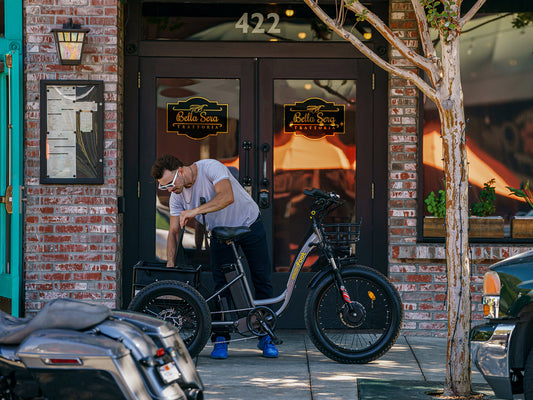In an era marked by a growing consciousness about health, fitness, and environmental sustainability, cycling has emerged as a popular mode of transportation. Along with this surge of two-wheeled travel comes the urgent need to understand and follow road safety guidelines, especially those outlined through road signs.
In this article, we'll dive into the complex labyrinth of signs, symbols, and markings that you're likely to encounter on the road, simplifying them into digestible information. From deciphering symbolic cues to understanding variations in shape and color, we've got you covered.
11 Bicycle Signs You Will Encounter on the Road
Navigating the roads on a bicycle comes with its own set of rules and signals, many of which are visually communicated through bike signs and lane markings. They provide critical information about road usage, potential hazards, and your rights and responsibilities as a cyclist.
However, these signs and their meanings can often be confusing, especially for beginner cyclists. Here’s a list of 11 bicycle signs you will see on the roads:
1. Standard Bike Lanes

Bike lanes with solid lines are the standard bike lanes you'll find in most cities. These lanes are typically marked with a bicycle symbol and may have an arrow depicting the path direction.
These lanes are designated for cyclists only but bikes don’t need to stay in them. For instance, if a car is parked in this zone, they would have to leave it to avoid hitting the car door.
2. Advisory Bike Lanes

Advisory bike lanes are marked with a solid line on the curbside and a dotted line on the traffic side. You will typically find it on a narrow road that receives little traffic and there’s chance motorists may enter the bike lane.
In fact, the dotted line signifies that motorists can enter from that side of the lane when necessary. So, cyclists need to be careful when driving in these lanes.
3. Buffered Bike Lanes

A buffered bike lane, distinct from a regular bike lane, includes a marked buffer zone separating it from the adjoining travel lanes. This buffer serves to provide extra space for cyclists and enhance safety. Marked with white chevrons, the buffer indicates a no-vehicle zone. Only bikes can use this lane, except when cars need to turn or get on or off the road.
4. Protected Bikeway

Protected bikeways, also known as cycle tracks, are areas designated solely for cyclists. They can be either one or two ways. They are completely separated from vehicular traffic by parked cars, medians, or curbs.
These lanes provide cyclists with a sense of security and comfort, being insulated from the regular flow of traffic. However, since parked cars are present, bikers should watch for car doors when driving in such lanes.
5. SHARROWS, or Shared Lanes

Sharrows, a term derived from "shared" and "arrow", mark lanes shared between cyclists and motorists. They are usually symbolized by a bicycle symbol with two arrows pointing in the direction of traffic.
They can be present in plain white or green color, indicating the same. Since it’s a shared lane, be sure to maintain a safe distance from other vehicles while using these lanes.
Green bike lanes can have straight or dashed lines. Here, dashed lines indicate this lane is not meant for cars (except when the car needs to enter a driveway).
6. Bike Boulevards

Unlike typical residential streets, bike boulevards are reserved for bicycles. They provide cyclists with a relaxing and safe environment, without the worry of vehicular traffic.
These are areas with less vehicular traffic and low-speed limits to enhance the safety of electric bikes or bicycle riders.
7. Green Bike Lanes

Green bike lanes are similar to the standard bike lanes but their green color highlights areas where motorists might cross a bike lane. The purpose is to warn cyclists and watch out for these motorcyclists.
8. Colored Bike Signs

Each color sign conveys a certain meaning. However, that meaning can change when the symbols change. For instance, a green road marker suggests motorists can enter a bike lane, while a green bike symbol signifies a recommended path for cyclists.
Yellow bike signs serve as a reminder that the road is shared with cyclists. A blue-circled bike symbol is a “bike only” sign.
9. Restriction Bike Traffic Sign

A sign displaying a red circle with a bicycle indicates that bicycles aren't allowed in that area. Other types of restrictions may also utilize a red circle, so it's important to understand these variations.
10. Bicycle Hand Signals

Hand signals are another crucial form of communication for cyclists. They include the turn signal, made by extending your arm in the direction you plan to turn, and the stop signal, signaled by lowering your left arm straight down with your palm facing behind.
11. Bike Box

A bike box is an area at the front of a traffic lane for cyclists to wait at red lights. They provide visibility and protection for cyclists and help them position for left turns.
Final Words
Understanding road safety bicycle signs is a crucial aspect of cycling, whether you ride a traditional bicycle or an electric one. The signs offer valuable information that helps ensure your safety and that of others on the road.
As bicycles and e-bikes become more common on city streets, all riders need to be well-versed in the meaning of these signs and adhere to them. By doing so, you contribute to safer roads and a better cycling experience for all.
Next time you get on your bike or e-bike, remember these signs, respect them, and ensure a safer and more enjoyable ride.




